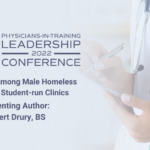Abstract | April 4, 2022
HIV Stigma Among Male Homeless Patients in Student-run Clinics
Learning Objectives
- Cite current data regarding HIV trends in US and Louisiana homeless populations
- Describe the obstacles homeless patients face in regards to HIV treatment
- Discuss the need for greater quantification of HIV stigma among homeless patients��
INTRODUCTION: Human immunodeficiency virus (HIV) and acquired immunodeficiency syndrome (AIDS) are major health issues within Louisiana. In 2018, Louisiana ranked 4th in the nation for both HIV and AIDS case rates. Additionally, Louisiana has a significant homeless population. Compared to nonhomeless people, individuals experiencing homelessness are at increased risk of developing HIV. The National Alliance to End Homelessness estimated that 3.4% of homeless individuals have HIV compared to only 0.4% of the general population.
Serious barriers exist for HIV treatment among homeless patients, including lack of follow-up, mental health obstacles, use of illicit drugs, and negative feelings towards healthcare providers. Another significant barrier is the stigmatization of HIV. Health-related stigmatization is when individuals experience adverse social or personal judgement due to their health issues. Within homeless population, data suggests perceived stigma causes individuals to withhold HIV status from social workers and sexual partners.
Research has begun to quantify the levels of stigma HIV patients face, especially in non-US countries. However, further research is needed regarding the amount of stigma US homeless populations have towards HIV. Greater understanding will enable healthcare providers to better address HIV stigma as well as measure improvement after intervention in homeless patients.
OBJECTIVE: Our goal is to quantify the amount of HIV stigma harbored by homeless patients. To accomplish this purpose, we will use an adaption of the Van Rie HIV/AIDS-related Stigma Scale. This questionnaire provides statements (e.g., “People who have HIV lose friends when they share with them they have HIV”) that patients answer via a Likert response scale (e.g., “strongly disagree,” “disagree,” “agree,” and “strongly agree”). Male HIV-negative homeless patients will be administered this survey in student-run clinics in New Orleans. Mean scores will be computed to assess the burden of HIV stigma in this population.

